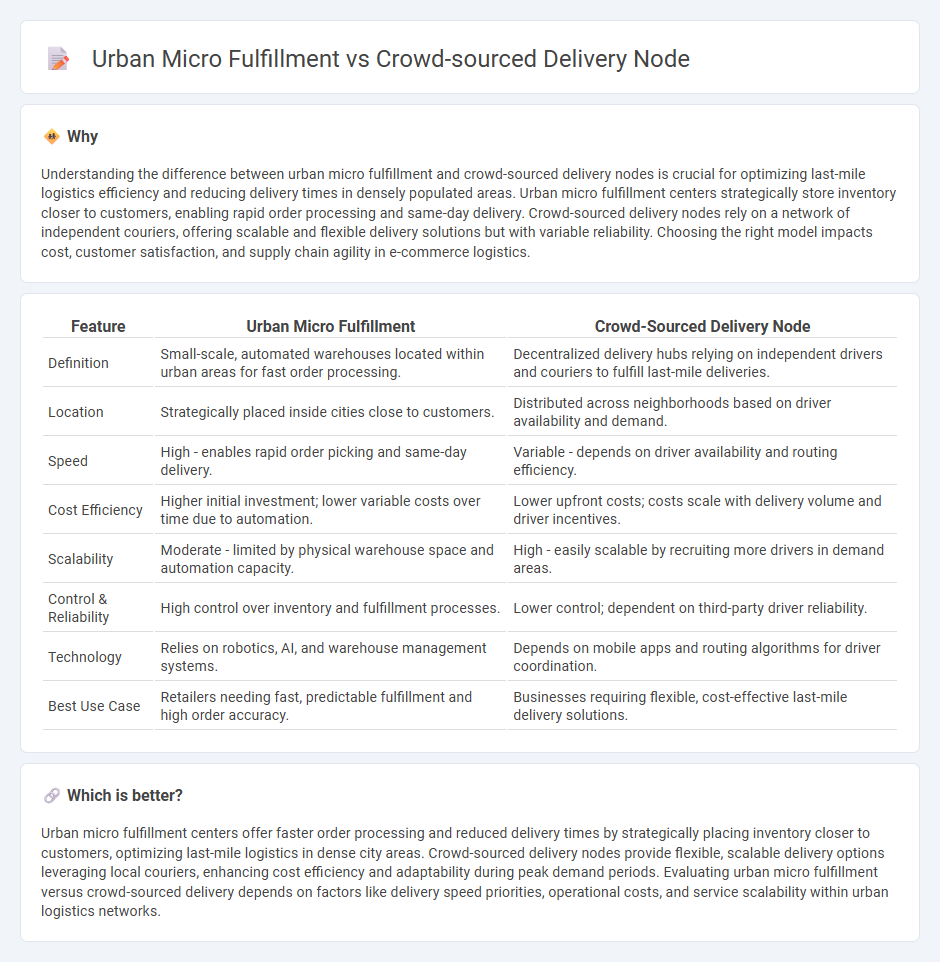
Urban micro-fulfillment centers enable rapid order processing and reduce last-mile delivery distances by strategically locating compact warehouses within city limits, enhancing supply chain efficiency. Crowd-sourced delivery nodes leverage local drivers and gig economy workers to provide flexible, on-demand delivery services, optimizing route planning and reducing delivery times. Explore how these innovative logistics models transform urban delivery systems and improve customer satisfaction.
Why it is important
Understanding the difference between urban micro fulfillment and crowd-sourced delivery nodes is crucial for optimizing last-mile logistics efficiency and reducing delivery times in densely populated areas. Urban micro fulfillment centers strategically store inventory closer to customers, enabling rapid order processing and same-day delivery. Crowd-sourced delivery nodes rely on a network of independent couriers, offering scalable and flexible delivery solutions but with variable reliability. Choosing the right model impacts cost, customer satisfaction, and supply chain agility in e-commerce logistics.
Comparison Table
| Feature | Urban Micro Fulfillment | Crowd-Sourced Delivery Node |
|---|---|---|
| Definition | Small-scale, automated warehouses located within urban areas for fast order processing. | Decentralized delivery hubs relying on independent drivers and couriers to fulfill last-mile deliveries. |
| Location | Strategically placed inside cities close to customers. | Distributed across neighborhoods based on driver availability and demand. |
| Speed | High - enables rapid order picking and same-day delivery. | Variable - depends on driver availability and routing efficiency. |
| Cost Efficiency | Higher initial investment; lower variable costs over time due to automation. | Lower upfront costs; costs scale with delivery volume and driver incentives. |
| Scalability | Moderate - limited by physical warehouse space and automation capacity. | High - easily scalable by recruiting more drivers in demand areas. |
| Control & Reliability | High control over inventory and fulfillment processes. | Lower control; dependent on third-party driver reliability. |
| Technology | Relies on robotics, AI, and warehouse management systems. | Depends on mobile apps and routing algorithms for driver coordination. |
| Best Use Case | Retailers needing fast, predictable fulfillment and high order accuracy. | Businesses requiring flexible, cost-effective last-mile delivery solutions. |
Which is better?
Urban micro fulfillment centers offer faster order processing and reduced delivery times by strategically placing inventory closer to customers, optimizing last-mile logistics in dense city areas. Crowd-sourced delivery nodes provide flexible, scalable delivery options leveraging local couriers, enhancing cost efficiency and adaptability during peak demand periods. Evaluating urban micro fulfillment versus crowd-sourced delivery depends on factors like delivery speed priorities, operational costs, and service scalability within urban logistics networks.
Connection
Urban micro fulfillment centers enhance last-mile logistics efficiency by positioning inventory closer to consumers, reducing delivery times and costs. Crowd-sourced delivery nodes leverage local, flexible workforce to execute rapid, scalable shipments from these micro fulfillment points. The integration of both models creates a dynamic, responsive urban logistics network that meets growing e-commerce demands.
Key Terms
Gig Economy
Crowd-sourced delivery nodes leverage gig economy workers to rapidly fulfill last-mile deliveries by tapping into a distributed network of independent contractors, optimizing urban logistics through real-time, flexible resource allocation. Urban micro fulfillment uses automated or semi-automated micro warehouses located close to consumers, reducing delivery times and operational costs while integrating gig workers primarily for last-mile tasks. Explore how these innovative models are reshaping e-commerce logistics and gig worker opportunities.
Decentralized Warehousing
Crowd-sourced delivery nodes leverage local individuals for last-mile distribution, enhancing flexibility and reducing delivery times through decentralized logistics. Urban micro-fulfillment centers, strategically placed in city areas, optimize inventory storage closer to end consumers, minimizing transportation costs and enabling rapid order processing. Explore the advantages and implementation strategies of decentralized warehousing to transform urban supply chains effectively.
Last Mile Optimization
Crowd-sourced delivery nodes leverage a network of independent local couriers to enhance flexibility and speed in last-mile delivery, reducing transit times and operational costs. Urban micro fulfillment centers, strategically located small warehouses within city limits, optimize inventory storage and facilitate rapid order processing, thereby improving delivery accuracy and scalability. Explore deeper insights into how these innovative solutions transform last-mile logistics and elevate customer satisfaction.
Source and External Links
What Is Crowdsourced Delivery & Why Is It Popular? - Crowdsourced delivery leverages local, contracted couriers using their own vehicles to fulfill last-mile deliveries, efficiently connecting packages from pickup to recipient without traditional courier fleets, typically coordinated via digital platforms.
Crowdsourced logistics: The pickup and delivery problem with transshipments and occasional drivers - Crowdsourced delivery nodes refer to transshipment points where occasional drivers can transfer loads to regular fleet vehicles, optimizing delivery routes and costs through a hybrid network model combining regular drivers and crowd couriers.
Modern Crowdsourcing for Last Mile Delivery: A Disruptive ... - A crowd-sourced delivery node is often a local store, warehouse, or pickup point integrated into a crowdsourced delivery network, enabling fast, flexible last-mile delivery by connecting local couriers with ready-to-ship goods near the customer.
 dowidth.com
dowidth.com